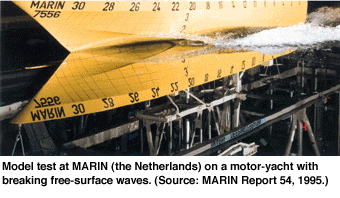New Numerical Methods for CFD applied to Ship Hull Design
by Henk Nieland
Computational Fluid Dynamics (CFD) is applied in a wide variety of industrial settings, for example computation of water flow around ship hulls or air flow around airplane wings. CWI has considerable experience in the research and development of numerical techniques to be used in CFD methods. A recent joint project with the Dutch Maritime Research Institute MARIN concerns the design of ship hulls using more realistic conditions.
CFD's founding father, John von Neumann, indulging himself in speculations about the possibilities of the emerging digital computer, stated in 1946 that numerical models would eventually completely replace analytic solutions of fluid dynamics equations and even experimental fluid dynamics. As usual, the child did not exactly become what the father hoped for (analytic and experimental methods are still with us), but by now CFD methods have become a prominent tool in many industrial settings and still form an active research field, to which CWI has made important contributions.
 CFD research at CWI concerns the computation of fluid flows for all
kinds of industrial applications. The fluids can be gases, liquids or combinations
of these (multi-phase flows). Research topics are: advanced discretization
methods for systems of nonlinear conservation laws, multigrid and sparse-grid
solution methods, local grid adaptation and distributed computing. Emphasis
lies on the development of sparse-grid algorithms for 3D flow problems.
CFD research at CWI concerns the computation of fluid flows for all
kinds of industrial applications. The fluids can be gases, liquids or combinations
of these (multi-phase flows). Research topics are: advanced discretization
methods for systems of nonlinear conservation laws, multigrid and sparse-grid
solution methods, local grid adaptation and distributed computing. Emphasis
lies on the development of sparse-grid algorithms for 3D flow problems.
In a joint 4-year project with MARIN, CWI develops improved Navier-Stokes methods for ship hydrodynamics, in order to increase the reliability and efficiency of MARIN's viscous CFD technology, which is presently restricted to steady, simplified Navier-Stokes equations and the corresponding computational domains to ship sterns and flat water surfaces. An extension will be made to the unsteady, full Navier-Stokes equations, with application to complete ships (bow and stern) and free-surface wave making. The new CFD methods will be applied to flow topology around ship hulls (flow separation, re-attachment, vortex formation, etc) at various sailing conditions (speed, trim, sinkage). Preliminary tests with flows around aircraft wings indicate that sparse-grid algorithms developed at CWI will also be effective when applied to ship hydrodynamics. More information on CWI's CFD project can be found at http://dbs.cwi.nl/cwwwi/owa/cwwwi.print_projects?ID=8.
Please contact:
Barry Koren - CWI
Tel: +31 20 592 4114
E-mail: Barry.Koren@cwi.nl
